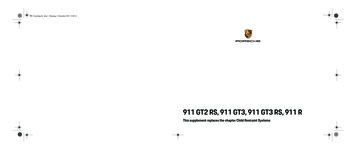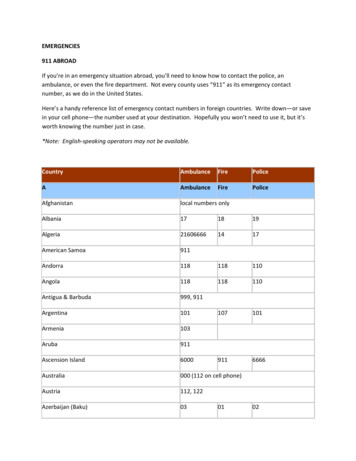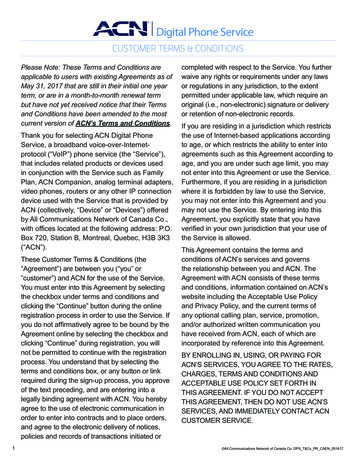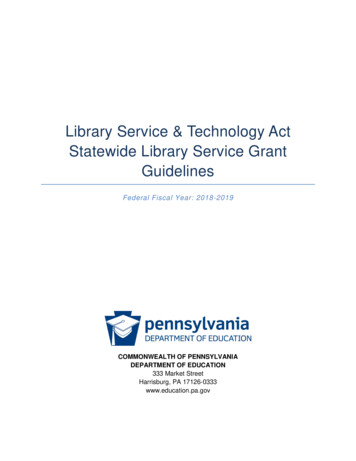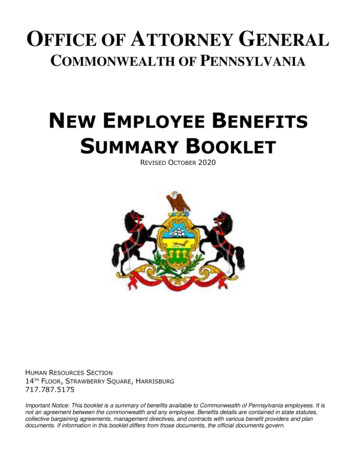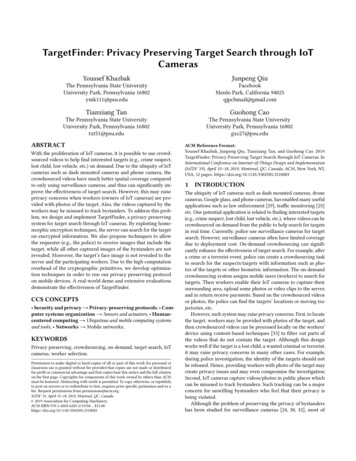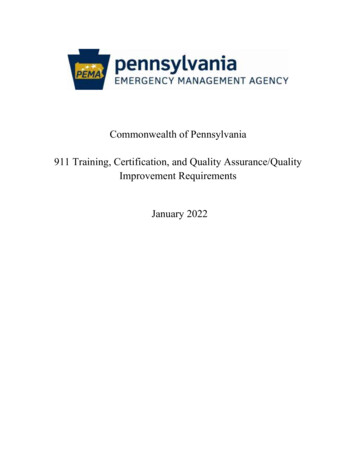
Transcription
Commonwealth of Pennsylvania911 Training, Certification, and Quality Assurance/QualityImprovement RequirementsJanuary 2022
PURPOSEThe Pennsylvania Emergency Management Agency (PEMA) is required by the 911 EmergencyCommunication Services Act (35 Pa. C.S. §§ 5301—5399) to adopt minimum training, certification,quality assurance (QA) and quality improvement (QI) requirements for call-takers, dispatchers,supervisors, and 911 coordinators.The purpose of this document is to establish minimum requirements for public safety answering point(PSAP) telecommunicator training programs and QA/QI programs, along with requirements forregistration and certification. This document replaces 4 Pa. Code Chapter 120c and 4 Pa. Code Chapter120d as the requirements for training, certification, and quality assurance for PSAPs in theCommonwealth. Funding for 911 services shall not be expended on a 911 system that does not conformto the requirements and guidance published by PEMA. See 35 Pa. C.S. § 5306.1 (c)(2). Compliance withthese requirements and guidance will be verified through PEMA’s certification review process.The goal of these requirements is to ensure that PSAP personnel receive the same minimum training, andadhere to the same QA/QI requirements, so that a consistent level of service is maintained throughout theCommonwealth.1
ContentsPURPOSE . 1DEFINITIONS . 3Article I.PSAP TRAINING PROGRAM OVERVIEW AND REQUIREMENTS . 6Section 1.01PURPOSE . 6Section 1.02OVERVIEW AND REQUIREMENTS . 6Section 1.03TRAINING LEVELS . 7Section 1.04MINIMUM CURRICULUM REQUIREMENTS FOR TRAINEE (BASIC/ENTRY-LEVELTELECOMMUNICATOR) RAINING . 7Section 1.05MINIMUM CURRICULUM REQUIREMENTS FOR CALL-TAKER TRAINING . 8Section 1.06MINIMUM CURRICULUM REQUIREMENTS FOR DISPATCHER TRAINING . 9Section 1.07MINIMUM CURRICULUM REQUIREMENTS FOR SUPERVISOR TRAINING . 10Section 1.08TRAINING REQUIREMENTS FOR 911 COORDINATORS . 10Section 1.09CERTIFICATION . 10Section 1.10RECERTIFICATION AND CONTINUING EDUCATION REQUIREMENTS . 11Section 1.11RECIPROCITY . 12Section 1.12SPECIAL CONSIDERATIONS . 12Article II.CHAPTER 2 PSAP QA/QI PROGRAM OVERVIEW AND REQUIREMENTS. 13Section 2.01PURPOSE . 13Section 2.02OVERVIEW AND REQUIREMENTS . 13Section 2.03QA PROGRAM REQUIREMENTS . 13Section 2.04QA/QI CASE REVIEW STANDARD ADJUSTMENTS . 14Section 2.05QI PROGRAM REQUIREMENTS . 15Article III.CHAPTER 3 TRAINING AND QA/QI ADMINISTRATION REQUIREMENTS. 16Section 3.01PROGRAM DOCUMENTATION REQUIREMENTS . 16Section 3.02FUNDING . 16Section 3.03COMPLIANCE . 16Section 3.04CERTIFICATION PLAN REQUIREMENTS. 17Section 3.05NONCOMPLIANCE . 18Section 3.06VENDOR AND THIRD-PARTY CONSIDERATIONS. 18Section 3.07RETENTION OF RECORDS . 18Section 3.08RIGHT TO ENTER AND INSPECT . 182
DEFINITIONSThe following terms, when used in this document, have the following meanings, unless the content clearlyindicates otherwise:911 Coordinator - The 911 coordinator designated by the county as required by 35 Pa. C.S. § 5304 (a)(6).911 System – A public safety answering point.Act 12 of 2015 or Act 12 – The 911 Emergency Communication Services Act (35 Pa. C.S. § 5301—5399)Agency – The Pennsylvania Emergency Management Agency (PEMA)Board – The Pennsylvania Emergency Management Agency (PEMA) 911 Advisory BoardCall-Taker - A telecommunicator whose job duties include answering emergency and non-emergency callsfor service or handling other data (including text-to-911).Catastrophic Loss – An exceptional loss of human life and/or significant dollar amount of property damage.Certification Plan (CP) – A tool that provides PSAPs with a standard process for correctingnoncompliance with training, certification, or QA/QI requirements. Information a PSAP must provide ona CP includes actions that will be taken and resources required to resolve the noncompliance. The PSAPmust also provide the deliverable, measure, or indicator that will demonstrate the noncompliance has beenresolved.Certification/Recertification – Telecommunicator – Official recognition by the entity responsible for 911 operations within acounty’s jurisdiction that a telecommunicator (i.e., call-taker and/or dispatcher) has successfullycompleted all required courses and performance evaluations (e.g., written examination, practicalskills assessment) required by the PSAP’s telecommunicator training program. PEMA – Official recognition by the PEMA 911 Office that a PSAP’s telecommunicator trainingand QA/QI programs meet the minimum training and QA/QI requirements provided in thisdocument and that a PSAP complies with requirements, policies, and procedures stated in itstelecommunicator training and QA/QI programs.Certification Review – Activity conducted by the PEMA 911 Office to verify that a PSAP’stelecommunicator training and QA/QI programs comply with the minimum training and QA/QIrequirements adopted by PEMA, and that a PSAP complies with requirements, policies, and proceduresstated in its telecommunicator training and QA/QI programs. The activity includes, but is not limited to,both remote and onsite review of certification records, continuing education records, course curriculumand lesson plans, examination materials, and instructor records. The review does not include a3
performance review or skills assessment of PSAP personnel, nor a review of other personnel, PSAPactivities and/or financial activities not associated with the established telecommunicator training orQA/QI programs.Continuing Education Unit (CEU) – A PSAP-recognized method of quantifying participation in anorganized continuing education experience.County – The entity responsible for operating the 911 system within its jurisdiction, which is required bysection 5304 of 911 Emergency Communication Services Act. A county may provision a 911 system to serve itsjurisdiction through participation in a regional 911 system.Course Title – A portion of a PSAP’s curriculum that refers to a more specific description of the TrainingTopic of instruction.Curriculum – Specific learning standards to support the PSAPs training program. Curriculum shallconsist of the training topic and related course titles, delivery method, learning objective, instructionalhours, assessment, and optional lesson plans.Daily Observation Report (DOR) – A method used to evaluate the performance of a telecommunicator.Dispatcher - A telecommunicator whose job duties include, but are not limited to, dispatching emergencyand non-emergency calls for service.Emergency Call – A request for emergency assistance. An emergency call may be made as a traditionalvoice call, text call, video call or data-only call.Long-Term Case Review Standard Adjustment – A long-term adjustment to the 2% case review standardfor QA/QI programs. A long-term case review standard is valid for 1 year from the date of approval. Anexample of a situation when a long-term standard adjustment would be applicable includes but is notlimited to high emergency call volume exceeds the 2% threshold greater than available QA/QI staffpersonnel.Non - Emergency Call – Any call to a PSAP that is not an emergency call as defined in this sectionPEMA 911 Office – The entity responsible for adopting rules, regulations, and other actions necessary toimplement and enforce the provisions of the 911 Emergency Communication Services Act.Point of Contact (POC) – A PSAP-approved individual serving as the focal point of training and/or QA/QIinformation.Public Safety Answering Point (PSAP) – An agency-approved entity that receives 911 communicationsfrom a defined geographic area and processes those calls according to a specific operational policy. PSAPsin the Commonwealth are county-based. A county also may provide 911 service for its jurisdiction throughparticipation in a regional 911 system. The term “PSAP” for purposes of this document also shall applyto the term 911 system.4
Quality Assurance and Quality Improvement (QA/QI) Program – A PSAP process providing, at aminimum: a random case review to evaluate telecommunicator performance; feedback on protocolcompliance, commendation, retraining and remediation as appropriate; and submission of compliance datato the PEMA 911 Office.Quality Assurance Case Review – A review process that is used to assess the performance of thetelecommunicator in receiving and handling calls for service or dispatched events in accordance withestablished PSAP policies and procedures.Supervisor - A telecommunicator whose job duties include, but not limited to, directly supervising thosewho answer (call-taker) and/or dispatch (dispatcher) emergency and non-emergency calls for service.Telecommunicator – An individual employed by a PSAP whose primary responsibility is to receive,process, transmit, and/or dispatch emergency and non-emergency calls for service for emergency medical,fire/rescue, law enforcement and other public safety services, via telephone, radio, and othercommunication devices. The term telecommunicator includes call-takers, emergency dispatchers, andsupervisors.Telecommunicator Training Program – A program that prepares individuals for the telecommunicatorprofession. This program must comply with all training requirements adopted by the Commonwealth andincludes curriculum for classroom, on-the-job, recertification, promotional, remedial, and continuingeducation.Temporary Case Review Standard Adjustment – A temporary adjustment to the 2% case review standardfor QA/QI programs. A temporary case review standard is valid for 6 months from the date of approval.Examples of situations when temporary standard adjustments would be applicable include but are notlimited to QA/QI software implementation or upgrade, resignation of QA/QI staff personnel with limitedstaff replacement, or other situations where a long-term case review standard adjustment would not bereasonable.Trainee (Basic/Entry-Level Telecommunicator) - A minimum entry-level position that requires basictraining fundamentals of a PSAP environment.Training Record – A record for each telecommunicator employed by the PSAP that is a compilation ofall documentation, including specific training and completion date.Training Topic – A minimum requirement provided in Sections 1.04 – 1.07 of this document that must beincluded in a PSAP’s documented telecommunicator training curriculum based on the positions utilized inthe PSAP. All course titles in a PSAP’s training program that are associated with a Training Topic mustbe included in the PSAP’s documented curriculumWritten Directives – A set of PSAP-specific policies, procedures, rules, regulations, and guidelines onPSAP letterhead and authorized by the PSAP management.5
Article I.PSAP TRAINING PROGRAM OVERVIEW AND REQUIREMENTSSection 1.01 PURPOSEThe purpose of these requirements is to ensure that personnel who receive, process and/or dispatchemergency calls for service receive the same minimum training requirements, to maintain a consistentlevel of service throughout the Commonwealth.These requirements are based upon national standards developed in cooperation with the Association ofPublic-Safety Communications Officials (APCO), National 911 Program, National Association of State911 Administrators (NASNA), National Emergency Number Association (NENA), National FireProtection Association (NFPA), and industry professionals.PSAPs shall establish training programs comprehensive of the minimum telecommunicator trainingrequirements. These requirements are in no way intended to limit the ability of a PSAP to conduct a morein-depth training process or include additional training requirements above the minimum. The PEMA 911Office recognizes PSAPs that choose to deliver supplemental training beyond these minimumrequirements.Section 1.02 OVERVIEW AND REQUIREMENTSa) Minimum requirements for a telecommunicator training program are provided in this documentand will be maintained annually by the PEMA 911 Office in consultation with the 911 AdvisoryBoard.b) Each PSAP shall establish and maintain a telecommunicator training program that includes theminimum requirements outlined in this document.c) A PSAP may include additional requirements that exceed the minimum requirements as part of itstelecommunicator training program. Nothing in this document should be construed to limit orrestrict any additional training that a PSAP may elect to include in its telecommunicator trainingprogram.d) Each PSAP shall document the curriculum and written directives of its telecommunicator trainingprogram using the format and procedures prescribed by the PEMA 911 Office.e) All telecommunicator training programs shall document and demonstrate instructional hours (orother measurement) for each training topic and all related course title(s) included in the PSAP’sprogram.f) All telecommunicator training programs shall include requirements for continuing education andrecertification.g) Each PSAP shall provide telecommunicator training and related materials.h) A PSAP’s telecommunicator training program and related materials shall be evaluated and revisedannually by the PSAP for relevance and quality. Program changes shall be reflected in the PSAPsdocumented training and certification program at the time of revision.i) Each PSAP shall designate a training point of contact (POC) for its telecommunicator trainingprogram.6
j) The training POC shall provide the PEMA 911 Office with documentation and informationregarding the PSAP’s training process.Section 1.03 TRAINING LEVELSa) Four levels of training, along with minimum training requirements for each training level, areestablished for telecommunicators in Section 1.04 through Section 1.07 of this document. The fourlevels of training include:i.Trainee (basic/entry-level ervisorb) A PSAP’s telecommunicator training program shall have a documented curriculum that meets orexceeds the minimum requirements set forth by the PEMA 911 Office for trainees, call-takers,dispatchers, and supervisors based on the positions utilized in the PSAP.c) A PSAP may have position-specific training requirements that combine the minimum trainingrequirements for multiple training levels based on its organizational structure. If a PSAP combinesthe minimum requirements for multiple training levels as part of the training for a specific position,the minimum requirements for each training level shall be satisfied before an employee is certifiedby the PSAP in that respective role.d) The minimum training requirements for trainee shall be completed before an individual handlesemergency calls for service regardless of the job title used by a PSAP.e) Completion of the trainee curriculum shall be a prerequisite to be certified as a call-taker,dispatcher or supervisor, or equivalent job classifications.f) Certified call-takers, dispatchers, and supervisors shall maintain active certifications to performtheir job duties.g) 911 Coordinators must meet the training requirements established in Section 1.08.Section 1.04 MINIMUM CURRICULUM REQUIREMENTS FOR TRAINEE(BASIC/ENTRY-LEVEL TELECOMMUNICATOR) TRAININGa) All PSAP trainee (basic/entry-level telecommunicator) training programs shall include thefollowing training topics:i. An industry recognized basic public safety telecommunicator course that covers all topicsincluded in APCO ANS 3.103.2.2015 - Minimum Training Standards for Public SafetyTelecommunicatorsii. Cardiopulmonary resuscitation (CPR) certificationiii. Introduction to the Incident Command System (ICS-100) *iv. Introduction to the National Incident Management System (IS-700) *v. Local governance structurevi. Governmental and private resourcesvii. PSAP and departmental written directivesviii.Media information/disseminationix. Pennsylvania Emergency Incident Reporting System (PEIRS)7
x. Jurisdiction-specific geography trainingxi. Hazardous materials (HAZMAT) awarenessxii. Securityxiii.Backup/contingency procedure training (disaster recovery/continuity of operations)xiv. Job-related equipment training with practical demonstration of skillxv. Workstation observation by traineexvi. Introduction to PSAP’s On-the-Job (OJT) training and Daily ObservationReports (DOR’s).Section 1.05 MINIMUM CURRICULUM REQUIREMENTS FOR CALL-TAKER TRAININGa) Section 1.04 Requirements.b) All PSAP call-taker training programs shall include the following training topics:i. Call receiving/processingii. Interviewing/interrogation techniquesiii. Controlling the calliv. Managing high-risk callsv. Managing specialty callsvi. Call categorization/prioritizationvii. Event categorizationviii.Homeland security/terrorism/weapons of mass destruction (WMD)ix. Aircraft/rail/marine incidentsx. Missing/exploited/trafficked personsxi. Special-needs callersxii. PSAP and departmental written directivesxiii.Job-related equipment training with practical demonstration of skillxiv. Workstation observation by Call-taker traineexv. On-the-job training programs with DORsxvi. Emergency medical dispatch, emergency fire dispatch, and emergency lawenforcement/police dispatch protocols shall be used by all PSAPs. Structured call-takingprotocol training directly related to the types of calls the PSAP is responsible for isrequired.c) Call-takers whose duty it is to process medical calls shall receive protocol training that address thefollowing topics:i.Emergency medical services (EMS) overviewii. EMS call processingiii. Emergency medical dispatch (EMD)d) Call-takers whose duty it is to process fire calls shall receive protocol training that address thefollowing topics:i.Fire service overviewii. Fire service call processingiii. Emergency fire dispatch (EFD)e) Call-takers whose duty it is to process law enforcement calls shall receive protocol training that8
address the following topics:i.Law enforcement overviewii. Law enforcement call processingiii. Emergency law enforcement dispatch/police dispatch systems (PDS)f) PSAPs shall meet the call-taking protocol requirement either by contracting with an industryrecognized call taking interrogation vendor or by PSAP-developed programs, adhering to thecriteria within this document. PEMA will not have a role in certifying a PSAPs protocols.g) When providing structured call-taking protocol training, PSAP-developed programs shall complywith following criteria:h) Develop training, certification, and recertification processes for the appropriate call-takingprotocol(s) with minimum requirements defined.i.Minimum continuing education requirements and performance appraisal with a formalassessment of knowledge and skills after a pre-defined time (e.g., every two years).ii. Call-taking protocols shall contain questions and a decision support process to facilitatecorrect call categorization and prioritization.iii. Call-taking protocols shall provide a specific, reproducible set of PSAP approved codesfor classifying calls and assigning a response, with tiered response levels and responsetypes associated with each code.iv. Call-taking protocols shall contain pre-arrival instructions for callers that are designed toprovide specific, safe, and appropriate actions for the layperson caller to promote thesafety, welfare, and successful outcome of the call for service.v. Each PSAP shall establish minimum protocol-compliance standards including each areaof the protocol used (e.g., address verification, chief complaint or incident typeidentification, caller interrogation questions, pre-arrival instructions, call classificationand coding, and overall case compliance).vi. Each PSAP shall establish contingency/alternate (pre-arrival) instructions for large-scaleincidents and disasters.i) Call-takers shall not process calls independently until they are certified as such by protocoltraining.Section 1.06 MINIMUM CURRICULUM REQUIREMENTS FOR DISPATCHER TRAININGa) Section 1.04 Requirements.b) All PSAP dispatcher training programs shall include the following training topics:i.Radio communication techniquesii.Radio technology and equipmentiii.Radio disciplineiv.Federal Communications Commission (FCC) rulesv.Specific PSAP radio-use written directivesvi.Job-related equipment training with practical demonstration of skillvii.Workstation observation by Dispatcher traineeviii.On-the-job training programs with DORs9
Section 1.07 MINIMUM CURRICULUM REQUIREMENTS FOR SUPERVISOR TRAININGa) Section 1.04 Requirements.b) All PSAP supervisor-level training programs shall include the following training topics:i.A public safety supervisor training course that covers: The telecommunications supervisor role Administrative functions, including complaint investigation Supervision and leadership concepts and principles Liability issues for supervisors Communication skills Self-assessment Employee evaluation and motivationii.PSAP-specific supervisor training regarding written directivesiii.Incident Command for Single Resources and Initial Action Incidents (ICS-200) *iv.National Response Framework, an Introduction (IS-800) *v.Job-related equipment/software training with practical demonstration of skill.vi.Written assessment (i.e., checklist, DOR, etc.) documenting the completion of training.Note: * any iteration will be acceptedSection 1.08 TRAINING REQUIREMENTS FOR 911 COORDINATORSa) 911 coordinators shall meet the following training requirements:i.Introduction to the Incident Command System (ICS-100) *ii.Incident Command for Single Resources and Initial Action Incidents (ICS-200) *iii.Intermediate ICS for Expanding Incidents (ICS-300) *iv.An Introduction to the National Incident Management System (IS-700) *v.National Response Framework, an Introduction (IS-800) *vi.Attend at least one 911 Advisory Board meeting annually or PEMA hosted 911 in-servicetrainingvii.Attend one industry conference or workshop bienniallyNote: * any iteration will be acceptedSection 1.09 CERTIFICATIONa) To be certified as a telecommunicator (call-taker, dispatcher, or supervisor or equivalent jobclassification) by a PSAP, candidates shall meet the following criteria:i.Be at least 18 years of ageii.Possess a high school diploma or general equivalency diploma (GED)iii.Be free of a criminal history that would prohibit them from successfully fulfilling all dutiesof the position as defined by the employeriv.Meet any additional employer-specific qualifications to be hired as a telecommunicator(e.g., pre-employment testing)v.Complete trainee (basic/entry-level) telecommunicator training10
b) Each PSAP will certify its call-takers, dispatchers, and supervisors, or equivalent, who successfullycomplete training for a position, based on the job titles and requirements identified in itstelecommunicator training program.i.Once the PSAP’s training and certification program is certified by the PEMA 911 Office,a telecommunicator who is employed on, or before the program certification date, whetherthe individual is working full-time or part-time as a permanent or temporary employee,shall comply with the training and certification requirements provided in the PSAP’scertified program within one calendar year of the program being certified by PEMA 911Office.ii.c)d)e)f)A telecommunicator who is employed after the program certification date, whether theindividual is working full-time or part-time as a permanent or temporary employee, shallcomply with all training and certification requirements provided in the PSAP’s certifiedprogram.Certification is valid for two years after the date of issuance.The PEMA 911 Office shall rely on the certification of each telecommunicator, as provided to itby the individual PSAP, to be accurate.Each PSAP shall notify the PEMA 911 Office using the prescribed methodology, within 30 daysof certification issuance to its telecommunicators.The PEMA 911 Office will be responsible for certifying each PSAP’s telecommunicator trainingprogram for compliance with the minimum training requirements adopted by PEMA, and that aPSAP complies with the curriculum, requirements, policies, and procedures stated in itstelecommunicator training program.Section 1.10 RECERTIFICATION AND CONTINUING EDUCATION REQUIREMENTSa) Call-takers, dispatchers, and supervisors, or equivalent shall maintain valid certifications.b) The PSAP shall have, as part of its training program, a defined recertification process for eachposition it certifies.c) The recertification process shall include a requirement for each defined position to complete at aminimum 24 continuing education unit (CEU) requirements every two years.d) The CEU requirements should be organized around the duties and tasks the telecommunicator isperforming. The CEUs should be focused on enabling the telecommunicator to:i.Develop a better understanding of telecommunications and the telecommunicator’s rolesand responsibilitiesii.Enhance job skillsiii.Keep up to date on emerging issuesiv.Provide opportunities for discussion, skill practice, and critique of skill performancee) The PSAP shall document all CEU topic and hours for each telecommunicator to show compliancewith these requirements.f) The Training POC shall notify the PEMA 911 Office, using the prescribed methodology, within30 days of all recertifications.11
Section 1.11 RECIPROCITYa) For telecommunicators certified under another Pennsylvania PSAP’s telecommunicator trainingprogram:i.Acceptance of previous certification is at the discretion of the receiving PSAP.ii.All lateral transfers shall meet the training and certification requirements of the receivingPSAP.Section 1.12 SPECIAL CONSIDERATIONSa) This section applies whenever a labor union agreement or a local employment condition requiresa PSAP to use job titles other than trainee, call-taker, dispatcher, or supervisor to describe PSAPpersonnel. Under these circumstances, the PSAP and the PEMA 911 Office shall jointly comparethe functions, duties, and responsibilities of each PSAP job position with the functions, duties andresponsibilities of a trainee, call-taker, dispatcher, or supervisor to determine which regulatoryposition (trainee, call-taker, dispatcher, or supervisor) most closely relates to the PSAP job position.b) After the joint determination has been made, either the trainee, call-taker, dispatcher or supervisortraining and certification requirements of this document shall be applied to those individual PSAPjob positions. If a PSAP and the PEMA 911 Office fail to agree on the appropriate training andcertification requirements for a PSAP job position, the PEMA 911 Office shall, at its owndiscretion, decide the matter.12
Article II.CHAPTER 2 PSAP QA/QI PROGRAM OVERVIEW AND REQUIREMENTSSection 2.01 PURPOSEA QA/QI program is vital to a PSAP’s ability to ensure that incidents are processed in a consistent,effective, and efficient manner. QA/QI programs allow the PSAP to critique itself, and to ensure that it ismeeting the public’s expectations of high-quality call-processing and customer-service skills.A QA/QI program should serve as an opportunity to correct deficiencies and reward accomplishments byan individual, team and/or PSAP. Not only does an effective QA/QI program provide a mechanism forthe review of incidents, it also serves to provide continual feedback to the telecommunicator and the PSAPfor improvement.These requirements align with APCO/NENA ANS 1.107.1.2015, Standard for the Establishment of aQuality Assurance and Quality Improvement Program for Public Safety Answering Points. Theserequirements are in no way intended to limit the ability of a PSAP to conduct a more in-depth QA/QIprocess.Section 2.02 OVERVIEW
registration and certification. This document replaces 4 Pa. Code Chapter 120c and 4 Pa. Code Chapter 120d as the requirements for training, certification, and quality assurance for PSAPs in the Commonwealth. Funding for 911 services shall not be expended on a 911 system that does not conform to the requirements and guidance published by PEMA.
